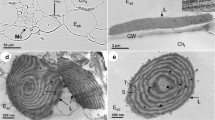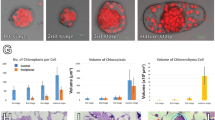Summary
Chloroplasts of many species of hornworts (Anthocerotae) have a structure that resembles the pyrenoid of green algae but whether these two structures are homologous has not been determined. We utilized immunogold labelling on thin sections to determine the distribution of ribulose 1,5-bisphosphate carboxylase/oxygenase (RuBisCO), the major protein of algal pyrenoids, in sixteen hornwort species with and without pyrenoids. Several species (Phaeoceros laevis, Anthoceros punctatus, A. formosae, A. laminiferus, Folioceros fuciformis, Folioceros sp.,Dendroceros tubercularis, D. japonicus, D. validus, Notothylas orbicularis, N. temperata, andSpaerosporoceros adscendens) have uniplastidic (or primarily uniplastidic) cells with large prominent multiple pyrenoids. In all of these species, the labelling is found exclusively in the pyrenoid and, with the exception of theFolioceros, Dendroceros, andNotothylas species, the labelling is randomly distributed throughout the pyrenoid. In the exceptional species, the pyrenoids have prominent pyrenoglobuli or other inclusions that are unlabelled. InMegaceros flagellaris andM. longispirus, the cells are multiplastidic (with the exception of the apical cell and some epidermal cells) and the chloroplasts lack pyrenoids.Anthoceros fusiformis andPhaeoceros coriaceus have primarily uniplastidic cells but the chloroplasts lack pyrenoids; only an area of stroma in the center of the plastid devoid of starch, reminiscent of a pyrenoid, is found. In all of the species lacking pyrenoids, RuBisCo is found throughout the stroma, including the stromal spaces made by the so-called channel thylakoids. No preferential accumulation of RuBisCo is found in the pyrenoid-like region inA. fusiformis andP. coriaceus. These data indicate that 1) the hornwort pyrenoid is homologous to algal pyrenoids in the presence of RuBisCo; 2) that at least some of the RuBisCo in the pyrenoid must represent an active form of the enzyme; and 3) that, in the absence of pyrenoids, the RuBisCo is distributed throughout the stroma, as in higher plants.
Similar content being viewed by others
Abbreviations
- RuBisCo:
-
ribulose 1,5-bisphosphate carboxylase/oxygenase
References
Brown RC, Lemmon BE (1985) Preprophasic establishment of division polarity in monoplastidic mitosis of hornworts. Protoplasma 124: 175–183
Burr FA (1968) Chloroplast structure and division inMegaceros species. Ph.D. dissertation, U. California, Berkeley
— (1970) Phyologenetic transitions in the chloroplasts of the Anthocerotales 1. The number and ultrastructure of the mature plastids. Amer J Bot 57: 97–110
Campbell EO (1971) Problems in the origin and classification of bryophyte with particular reference to liverworts. New Zealand J Bot 9: 678–688
Duckett JG, Renzaglia KS (1980) Ultrastructure and development of plastids in the bryophytes. Adv Bryol 3: 33–93
Gray JC, Kekwick RGO (1974) An immunological investigation of the structure and function of ribulose 1,5 bisphosphate carboxylase. Eur J Biochem 44: 481–489
Griffiths DJ (1970) The pyrenoid. Bot Rev 36: 29–58
— (1980) The pyrenoid and its role in algal metabolism. Sci Prog (Oxford) 66: 537–553
Hasegawa J (1983) Taxonomical studies on Asian Anthocerotae III. Asian species ofMegaceros. J Hattori Bot Lab 54: 227–240
Hassel de Menendez GG (1988) A proposal for a new classification of the genera within the Anthocerotophyta. J Hattori Bot Lab 64: 71–86
Kiss JZ, Vasconcelos AC, Triemer RE (1986) Paramylon synthesis and chloroplast structure associated with nutrient levels inEuglena (Euglenophyceae). J Phycol 22: 327–333
LaCoste-Royal G, Gibbs SP (1987) Immunocytochemical localization of ribulose-1,5-bisphosphate carboxylase in the pyrenoid and thylakoid region ofChlamydomonas reinhardi. Plant Physiol 83: 601–606
Laemmli UK (1970) Cleavage of structural protein during assembly of head of bacteriophage T4. Nature 227: 680–685
Lander CA (1935) The relation of plastid to nuclear division inAnthoceros laevis. Amer J Bot 22: 42–51
Manton I (1962) Observations on plastid development in the meristem ofAnthoceros. J Exp Bot 13: 325–333
McAllister F (1927) The pyrenoids ofAnthoceros andNotothylas with especial reference to their presence in spore mother cells. Amer J Bot 14: 246–257
McKay RML, Gibbs SP (1989 a) Immunocytochemical localization of ribulose 1,5-bisphosphate carboxylase/oxygenase in light-limited and light-saturated cells ofChlorella pyrenoidosa. Protoplasma 149: 31–37
— (1989 b) Phycoerythrin is absent from the pyrenoid ofPorphyridium cruenatum: photosynthetic implications. Plant Physiol 89 s: 82
Menke W (1961) Über die Chloroplasten vonAnthoceros punctatus. 5. Mitteilung zur Entwicklungsgeschichte der Plastiden. Naturforsch 16: 334–336
Okabe Y, Okada M (1988) Isolation of native pyrenoid core matrix having ribulose 1,5-bisphosphate carboxylase activity from the green algaeBryopsis maxima. Plant Cell Physiol 29: 89–96
Renzaglia KS (1978) A comparative morphology and developmental anatomy of the Anthocerotophyta. J Hattori Bot Lab 44: 31–90
Salisbury JL, Floyd GL (1978) Molecular, enzymatic and ultrastructural characterization of the pyrenoid of the scaly green monadMicromonas squamata. J Physiol 14: 362–368
Satoh H, Okada M, Nakayama K, Miyago K (1984) Purification and further characterization of pyrenoid proteins and ribulose 1,5-bisphosphate carboxylase/oxygenase from the green algaBryopsis maxima. Plant Cell Physiol 26: 931–940
Schuster RM (1987) Preliminary studies on Anthocerotae. Phytologia 63: 193–201
Valentine LJ, Campbell EO, Hopcroft DH (1986) A study of chloroplast structure in 3Megaceros species and 3Dendroceros species (Anthocerotae) indigenous toNew Zealand. New Zealand J Bot 24: 1–8
Vaughn KC (1987) Two immunological approaches to the detection of ribulose 1,5-bisphosphate carboxylase in guard cell chloroplasts. Plant Physiol 84: 188–196
—, Owen HA (1989) Organization of the hornwort (Anthocerotae) chloroplast. Plant Physiol 89 s: 83
Wilsenach R (1963) Differentiation of the chloroplast inAnthoceros. J Cell Biol 18: 419–428
Author information
Authors and Affiliations
Rights and permissions
About this article
Cite this article
Vaughn, K.C., Campbell, E.O., Hasegawa, J. et al. The pyrenoid is the site of ribulose 1,5-bisphosphate carboxylase/oxygenase accumulation in the hornwort (Bryophyta: Anthocerotae) chloroplast. Protoplasma 156, 117–129 (1990). https://doi.org/10.1007/BF01560650
Received:
Accepted:
Issue Date:
DOI: https://doi.org/10.1007/BF01560650




